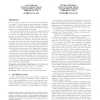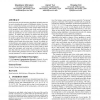267 search results - page 30 / 54 » Anti-Ramsey properties of random graphs |
ICML
2007
IEEE
14 years 9 months ago
2007
IEEE
A general framework is proposed for gradient boosting in supervised learning problems where the loss function is defined using a kernel over the output space. It extends boosting ...
ICS
2010
Tsinghua U.
14 years 6 months ago
2010
Tsinghua U.
: We initiate the study of local, sublinear time algorithms for finding vertices with extreme topological properties -- such as high degree or clustering coefficient -- in large so...
CVPR
2012
IEEE
11 years 11 months ago
2012
IEEE
A greedy-based approach to learn a compact and discriminative dictionary for sparse representation is presented. We propose an objective function consisting of two components: ent...
KDD
2006
ACM
14 years 9 months ago
2006
ACM
Given a huge real graph, how can we derive a representative sample? There are many known algorithms to compute interesting measures (shortest paths, centrality, betweenness, etc.)...
IMC
2010
ACM
13 years 6 months ago
2010
ACM
Social networks provide interesting algorithmic properties that can be used to bootstrap the security of distributed systems. For example, it is widely believed that social networ...


